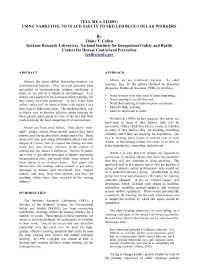Mining Publication: Tell Me a Story: Using Narrative to Teach Safety to Skilled Blue-Collar Workers
Original creation date: March 2003
Miners, like many skilled blue-collar workers, are not traditional learners. They have not generally been successful in classroom-type settings, preferring to learn on the job in a hands-on environment. U.S. miners are required to have annual safety training, but they rarely view this positively. In fact, it has been called "safety jail" by many of them, who regard it as a time to get a little extra sleep. The challenge then, was to find a way to develop effective safety training for these people, particularly in view of the fact that their work is among the most dangerous of all occupations.
Miners are born story tellers. They share "near-miss" stories, stories about master miners they have known, and stories about how things used to be. These stories not only pass along information about what will happen if a miner fails to respect the mining environment, they also instruct listeners in the culture of mining and the values it embraces. Stories, it seems, are a way to get safety messages to miners, especially inexperienced ones, and using older, wiser miners in these stories is an obvious choice. This paper will discuss how the training videos created to get safety messages to miners were developed, how "master miners" and story lines were chosen, and how the resulting videos have been received in the mining industry.
Authors: ET Cullen
Conference Paper - March 2003
NIOSHTIC2 Number: 20024066
In: Proceedings, Risk and Safety Management in Industry, Logistics, Transport, and Military Service: New Solutions for the 21st Century. London: U.S. Navy, Office Of Naval Research, International Field Office, 2003 Mar; :1-4
See Also
- The Evolving Mining Workforce: Training Issues
- An Ounce of Prevention: Training Workers to Prevent a Crisis
- An Overview of Technology and Training Simulations for Mine Rescue Teams
- An Overview of the Evaluation Process for Mine Trainers
- A Performance Approach to Training Research
- Principles of Adult Learning: Application for Mine Trainers
- Tell Me A Story... Using Stories to Improve Occupational Safety Training
- Tell Me a Story: Using Stories to Improve Occupational Safety Training
- Tell Me a Story: Why Stories are Essential to Effective Safety Training
- Working in the Classroom - A Vision of Miner Training in the 21st Century
- Page last reviewed: 9/21/2012
- Page last updated: 9/21/2012
- Content source: National Institute for Occupational Safety and Health, Mining Program


 ShareCompartir
ShareCompartir
